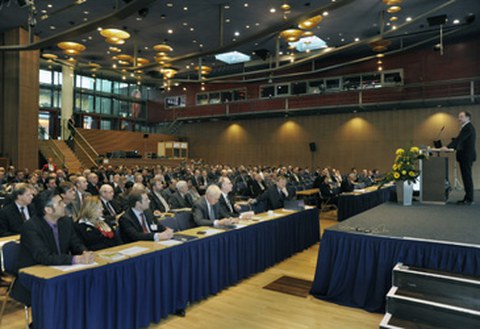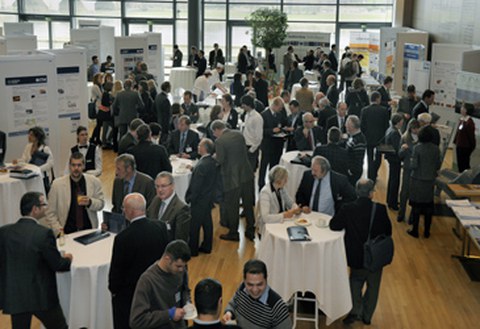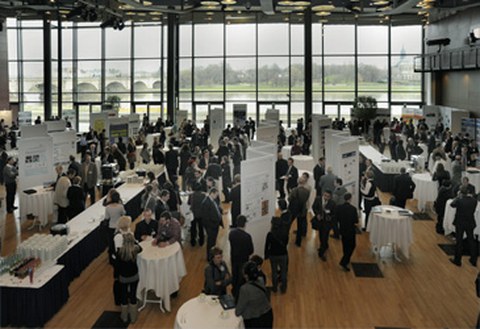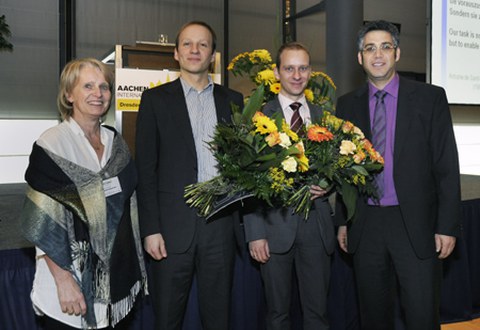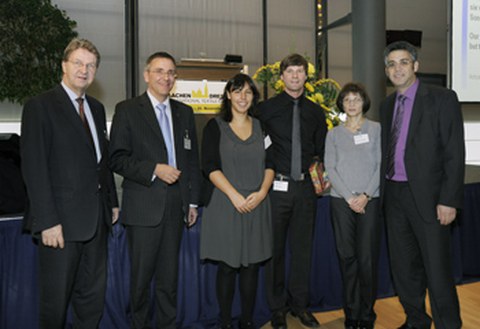Review of the 4th Aachen-Dresden International Textile Conference 2010
Over 550 participants from 30 countries attended the 4th Aachen-Dresden International Textile Conference 2010 in Dresden, held at the International Congress Centre.
Photo: TUD/Liebert
Addressing the general theme of the Conference, “Fibres – Membranes – Textiles: Key Technologies for High-Tech Applications and Products,” 41 lectures presented innovative material developments, surface modifications, functionalization of membranes and filters, new textile machine design and the most advanced protective textiles in two parallel sessions.
One such example was the innovative application of membranes and filters for harvesting energy and water treatment. Process integration and functionalization in textile machine design represented another important topic in the complete process chain. For many manufacturers of textile machinery, the flexibility and performance demands placed on today’s highly modern machines directly influences a company’s position and success in the global market. The participants were presented with several interesting examples of the integrated production of yarn and textile structures possessing various functions. As tradition demands for the Dresden Conference, various technical and personal protective textiles were presented under the rubric “Innovative Protective Textiles and Safety.” The participants saw protective textiles developed for industrial safety, applications for fire safety and the military as well as personal impact protection. In this section, the newest fibre and material developments, developments in textile structures for demanding applications and numerous types of functionalization were introduced.
The plenary session hosted lectures given by three exceptional, internationally reputed experts in the field of textiles.
Dr. Wagener from the Freudenberg Fuel Cell Component Technologies KG, Weinheim, Germany, presented some of the demands placed on technical non-wovens for use in fuel cells. In the future, these applications will become increasingly important in guaranteeing energy supply and maintaining mobility,
Prof. Pinnekamp from the Institute of Environmental Engineering at the RWTH Aachen, Germany, offered a deeper look into the invariably limited resource water. Using the example of a cotton crop and subsequent production, Prof. Pinnekamp demonstrated a method of calculating the amount of water required and the water flow created by trade with cotton products between nations.
Prof. Kiekens from the Department of Textiles, Ghent University, Belgium, offered a comprehensive overview of various innovative personal safety and protective textiles. His presentation included numerous examples exhibited at the 10 day NATO Conference “Defense Related Intelligent Textiles and Clothing for Ballistic and NBC (Nuclear, Biological, Chemical) Protection” held in April 2010 in Split, Croatia.
The two sessions which followed the plenary addresses hosted 38 speakers and presentations, showcasing the newest developments in surface engineering techniques and functionalization of membranes and filters with the goal of improving product properties. State of the art and novel design concepts for textile machinery as well as innovative protective textiles were also an integral part of the sessions.
Session 1 “Membranes and Filters – Surface Modifications, Functionalization and Effects” concentrated on new material developments and modifications aimed at finding new applications for filters and membranes. Applications for the harvesting of energy and water treatment were introduced. Global and national experts discussed block copolymer layers, hollow fibre applications for filter technology, plasma technology for the functionalization of fibres and textiles and the production of nano fibres to name just a few examples.
In Session 2 “Concepts for Textile Machinery: Process Integration and Functionalization,” the most recent technological innovations in machinery regarding the complete textile processing chain was presented and discussed. This year’s focus was on process integration, allowing the participants access to interesting examples of integrated production of yarn and textile structures exhibiting various functional properties. For companies designing and constructing textile machinery, flexibility and performance are key factors in design and are in high market demand.
As in the past, the Dresden Conference features “Innovative Protective Textiles” as part of Session 2, which again this year proved to be a highly interesting topic. On the second day of the Conference, technical and personal protective textiles were presented including those for industrial safety and security, fire protection, cryostatic applications, military, personal impact and the fishing sector. New innovations in fibre and material developments, textile structures which meet increasing demands and multiple textile functionalizations were presented to the participants. Additionally, testing requirements tailored to analyze products for specific applications were also discussed in further lectures.
Photos: TUD/Liebert
Comprehensive poster presentations complemented the lecture sessions this year at the 4th “Aachen-Dresdner.” Over 80 scientists and partners from the industry nationally and from abroad presented their newest research results. Additonally, the authors of selected posters presented the participants with their research in 4 short lecture blocks.
AWARDS 2010
Awarding of the Freundes- und Förderkreis des ITM der TU Dresden e.V.
Prof. Dr.-Ing. habil. Sybille Krzywinski, Dipl.-Wirtsch. Ing. Gregor Loukidis,
Dr.-Ing. Jan Hausding und Prof. Dr.-Ing. habil. Dipl.-Wirt. Ing. Chokri Cherif
Photo: TUD/Liebert
Poster Award 2010
Prof. Rudolph Haug (Hochschule Niederrhein), Prof. Dr. Thomas Gries (ITA, RWTH Aachen),
M. Sc. Anne Schwarz (Ghent University, Department of Textiles, Ghent/B),
Dipl.-Ing. Enrico Körner (Empa, Swiss Federal Laboratories for Materials Science and Technology, St. Gallen/CH),
Dr. Dorota Kowalczyk (Textile Research Institute, Łódź/PL),
Prof. Dr. Chokri Cherif (ITM)
Photo: TUD/Liebert
(from left to right)
- Anne Schwarz, Lieva Van Langenhove
Ghent University, Department of Textiles, Zwijnaarde (Belgium)
Electro-conductive textile structures and their possible applications
- Enrico Körner, Dirk Hegemann
Empa, Swiss Federal Laboratories for Materials Science and Technology, St. Gallen (Switzerland)
Antibacterial yet still cytocompatible plasma finishing of medical textiles
- Stefan Brzeziński, Dorota Kowalczyk, Grażyna Malinowska, Iwona Karbownik, Agnieszka Kaleta
Textile Research Institute, Łódź (Poland)
Effect of the nano-structuring of synthetic fabrics surface with corona discharge on the quality of pigment printings
More informationen and photos: http://www.aachen-dresden-itc.de.

